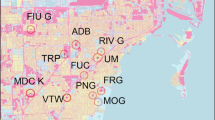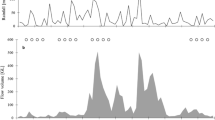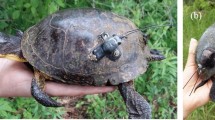Abstract
Development of coastal New England has led to the replacement of up to 37% of salt marshes with degraded freshwater wetlands, primarily through tidal restrictions. Removing these restrictions to restore salt marsh ecology would improve water quality, increase flood and storm protection, nutrient filtration, erosion control, and carbon sequestration. However, such restorations replace functional freshwater wetlands and could potentially impact freshwater species. Freshwater-dependent wildlife species such as the spotted turtle (Clemmys guttata), may be especially vulnerable to rapid changes in habitat resulting from tidal reintroduction due to their high site fidelity and limited ability to disperse quickly. Conservation of genetically and physically isolated spotted turtle populations as well as the restoration of salt marshes to mitigate climate change impacts are both high priorities on Nantucket Island. These two priorities conflicted in a project to restore tidal hydrology to an impounded freshwater marsh known to host a robust spotted turtle population. We evaluated changes to spotted turtle home range size and location and habitat use in response to salt marsh restoration over eight years. Home range size did not change but the location of home ranges shifted into bordering wetlands landward of the tidal salt water influence. Spotted turtles selected remaining freshwater marshes and shrub swamps while avoiding developed land and areas of establishing salt marsh within areas that had previously been high quality habitat. This study suggests prioritizing conservation of wetlands adjacent to planned salt marsh restoration to provide habitat for freshwater species to migrate.

Similar content being viewed by others
Data availability
The data that support the findings of this study are available from the corresponding author upon reasonable request.
References
Aebisher NJ, Robertson PA, Kenward RE (1993) Compositional analysis of habitat use from animal radio-tracking data. Ecology 74(5):1313–1325
Agha M, Ennen JR, Bower DS, Nowakowski AJ, Sweat SC, Todd BD (2018) Salinity tolerances and use of saline environments by freshwater turtles: implications of sea level rise. Biol Rev 93(3):1634–1648
Anisfeld SC (2012) Biochemical responses to tidal restoration. In: Roman CT, Burdick DM (eds) Tidal marsh restoration: a synthesis of science and management. Island Press, Washington, DC, pp 39–58
Beaudry F, deMaynadier PG, Hunter ML Jr (2009) Seasonally dynamic habitat use by spotted (Clemmys guttata) and Blanding’s turtles (Emydoidea blandingii) in Maine. J Herpetol 43(4):636–645
Boarman WI, Goodlett T, Goodlett G, Hamilton P (1998) Review of radio transmitter attachment techniques for turtle research and recommendations for improvement. Herpetol Rev 29(1):26–33
Bromberg KD, Bertness MD (2005) Reconstructing New England salt marsh losses using historic maps. Estuaries Coasts 28(6):823–832
Burdick DM, Dionne M, Boumans RM, Short FT (1996) Ecological responses to tidal restoration of two New England salt marshes. Wetlands Ecol Manage 4(2):129–144
Cagle FR (1939) A system of marking turtles for future identification. Copeia 1939(3):170–173
Carvalho SB, Brito JC, Crespo EJ, Possingham HP (2010) From climate change predictions to actions – conserving vulnerable animal groups in hotspots at a regional scale. Global Change Biol 16:3257–3270
Chmura GL, Burdick DM, Moore GE (2012) Recovering salt marsh ecosystem services through tidal restoration. In: Roman CT, Burdick DM (eds) Tidal marsh restoration: a synthesis of science and management. Island Press, Washington, DC, pp 233–252
Congdon JD, Dunham AE, van Loben Sels RC (1993) Delayed sexual maturity and demographics of Blanding’s turtles (Emydoidea blandingii): Implications for conservation and management of long-lived organisms. Conserv Biol 7:826–833
Ernst CH (1975) Growth of the spotted turtle, Clemmys guttata. J Herpetol 9(3):313–318
Ernst CH (1976) Ecology of the spotted turtle, Clemmys guttata (Reptilia, Testudines, Testudinidae) Southeastern Pennsylvania. J Herpetol 10(1):25–33
Ernst CH (1982) Environmental temperatures and activities in wild spotted turtles Clemmys guttata. J Herpetol 16(2):112–120
Ernst CH, Lovich JE (2009) Turtles of the United States and Canada, 2nd edn. The Johns Hopkins University Press, Baltimore, MD
Gibbons JW (1986) Movement patterns among turtle populations: applicability to management of the desert tortoise. Herpetologica 42(1):104–113
Gibbons JW, Scott DE, Ryan TJ, Buhlmann KA, Tuberville TE, Metts BS, Greene JL, Mills T, Leiden Y, Poppy S, Winne CT (2000) The global decline of reptiles, déjà vu amphibians. Biosci 50(8):653–666
Graham TE (1995) Habitat use and population parameters of the spotted turtle, Clemmys guttata, a species of special concern in Massachusetts. Chelonian Conserv Biol 1(3):207–214
Haxton T, Berrill M (1999) Habitat selectivity of Clemmys guttata in central Ontario. Can J Zool 77:593–599
Haxton T, Berrill M (2001) Seasonal activity in spotted turtles in a northern population. J Herpetol 35(4):606–614
Hobbs RJ (2004) Restoration ecology: the challenge of social values and expectations. Front Ecol Environ 2(1):43–48
Hobbs RJ (2016) Degraded or just different? Perceptions and value judgements in restoration decisions. Restor Ecol 24(2):153–158
IBM Corp. 2012. IBM SPSS Statistics for Windows, Version 21.0. IBM Corp., Armonk, NY
Jennrich RI, Turner FB (1969) Measurement of non-circular home range. J Theor Biol 22:227–237
Johnson DH (1980) The comparison of usage and availability measurements for evaluating resource preference. Ecology 61:65–71
Joyal LA, McCollough M, Hunter ML Jr (2001) Landscape ecology approaches to wetland species conservation: a case study of two turtle species in southern Maine. Conserv Biol 15(6):1755–1762
Karberg JM, Beattie KC, O’Dell DI, Omand KA (2018) Tidal hydrology and salinity drives salt marsh vegetation restoration and Phragmites australis control in New England. Wetlands 38(5):993–1003
Kenward RE (2001) A Manual for Wildlife Radio Tagging. Academic Press, New York
Kinneary JJ (1992) The effect of water salinity on growth and oxygen consumption of snapping turtle (Chelydra sepentina) hatchlings from an estuarine habitat. J Herpetol 26(4):461–467
Litzgus JD (2004) Mousseau TA (2004) Home range and seasonal activity of southern spotted turtles (Clemmys guttata): implications for management. Copeia 4:804–817
Litzgus JD (1998) Brooks RJ (1998) Testing the validity of counts of plastral scute rings in spotted turtles (Clemmys guttata). Copeia 1:222–225
Litzgus JD (2006) Sex differences in longevity in the spotted turtle (Clemmys guttata). Copeia 2006(2):281–288
Milam JC, Melvin SM (2001) Density, habitat use, movements, and conservation of spotted turtles (Clemmys guttata) in Massachusetts. J Herpetol 35(3):418–427
MacBroom JG, Schiff R (2012) Predicting the hydrologic response of salt marshes to tidal restoration: the science and practice of hydraulic modelling. In: Roman CT, Burdick DM (eds) Tidal marsh restoration: a synthesis of science and management. Island Press, Washington, DC, pp 13–38
MNHESP 2017: http://www.mass.gov/eea/docs/dfg/nhesp/natural-communities-facts/deep-emergent-marsh-fs.pdf
R Core Team. 2015. R: A language and environment for statistical computing. R Foundation for Statistical Computing, Vienna, Austria. http://www.R-project.org/.
Raposa KB, Talley DM (2012) A meta-analysis of nekton responses to restoration of tide-restricted New England salt marshes. In: Roman CT, Burdick DM (eds) Tidal marsh restoration: a synthesis of science and management. Island Press, Washington, DC, pp 97–118
Rasmussen ML (2010) Litzgus JD (2010) Habitat selection and movement patterns of spotted turtles (Clemmys guttata): effects of spatial and temporal scales of analyses. Copeia 1:86–96
Robertson PA, Aebischer NJ, Kenward RE, Hanski IK, Williams NP (1998) Simulation and jack-knifing assessment of home range indices based on underlying trajectories. J Appl Ecol 35:928–940
Roman CT, Burdick DM (2012) A synthesis of research and practice on restoring tides to salt marshes. In: Roman CT, Burdick DM (eds) Tidal marsh restoration: a synthesis of science and management. Island Press, Washington, DC, pp 3–10
Row JR (2006) Blouin-Demers G (2006) Kernels are not accurate estimates of home-range size for herpetofauna. Copeia 4:797–802
Smith SM, Warren RS (2012) Vegetation responses to tidal restoration. In: Roman CT, Burdick DM (eds) Tidal marsh restoration: a synthesis of science and management. Island Press, Washington, DC, pp 59–80
Suding KN (2011) Toward an era of restoration in ecology: successes, failures, and opportunities ahead. Annu Rev Eco Evol Syst 42:465–487
(TNC) The Nature Conservancy. (1998) Vegetation Community Map of Nantucket. GIS Data Layer, The Nature Conservancy, Arlington, VA
Warren RS, Fell PE, Rozsa R, Brawley AH, Orsted AC, Olson ET, Swamy V, Neiring WA (2002) Salt marsh restoration in Connecticut: 20 years of science and management. Restor Ecol 10(3):497–513
Acknowledgements
The authors wish to thank the Medouie Creek Homeowner Association for support of this project, particularly the Yuen Family, the O’Brien Family, and Bob Wright, for allowing access to their properties to track spotted turtles. Additionally, we wish to thank our colleague Neil Foley for reviewing this manuscript, donations from an anonymous SciFund crowdfunding event, as well as all the seasonal field assistants and volunteers for their many hard and buggy hours spent slogging through bogs and salt marshes for this project.
Funding
Funding for this research was provided by the Nantucket Conservation Foundation with additional minor donations through a SciFund Crowdfund.
Author information
Authors and Affiliations
Contributions
All authors contributed to the study conception and design. Material preparation and data collection were performed by DO. Data analyses were performed by DO and JK. The first draft of the manuscript was written by DO, KB and JK. All authors commented on previous version of the manuscript. All authors read and approved the final manuscript.
Corresponding author
Ethics declarations
Conflict of interest
The authors have no conflicts of interest to declare that are relevant to the content of this article.
Animal research/ethics
Protocols for the use of wild animals in this research were approved and permitted by the Massachusetts Division of Fisheries and Wildlife.
Consent for publication
The authors give consent for this manuscript to be published in Wetlands Ecology and Management.
Additional information
Publisher's Note
Springer Nature remains neutral with regard to jurisdictional claims in published maps and institutional affiliations.
Rights and permissions
About this article
Cite this article
O’Dell, D.I., Karberg, J.M., Beattie, K.C. et al. Changes to spotted turtle (Clemmys guttata) habitat selection in response to a salt marsh restoration. Wetlands Ecol Manage 29, 301–313 (2021). https://doi.org/10.1007/s11273-021-09788-7
Received:
Accepted:
Published:
Issue Date:
DOI: https://doi.org/10.1007/s11273-021-09788-7




